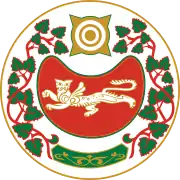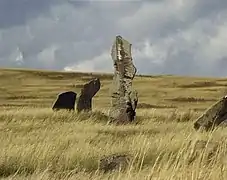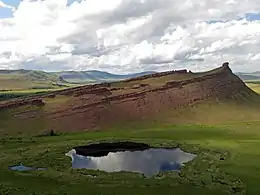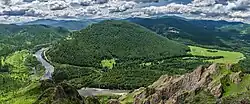Khakassia
Khakassia[lower-alpha 1] (/xəˈkæsɪə, kə-/), officially the Republic of Khakassia,[note 1] is a republic of Russia located in southern Siberia.[13] It is situated between Krasnoyarsk Krai to the north and the Altai Republic to the south.
Republic of Khakassia | |
|---|---|
| Республика Хакасия | |
| Other transcription(s) | |
| • Khakas | Хакас Республиказы |
 Coat of arms | |
| Anthem: Xakas gįmn (State Anthem of the Republic of Khakassia) [1] | |
 | |
| Coordinates: 53°30′N 90°00′E | |
| Country | Russia |
| Federal district | Siberian[2] |
| Economic region | East Siberian[3] |
| Capital | Abakan |
| Government | |
| • Body | Supreme Council[4] |
| • Head[5] | Valentin Konovalov[6] |
| Area | |
| • Total | 61,569 km2 (23,772 sq mi) |
| • Rank | 46th |
| Population | |
| • Total | 532,403 |
| • Estimate (2018)[9] | 537,513 |
| • Rank | 69th |
| • Density | 8.6/km2 (22/sq mi) |
| • Urban | 68.4% |
| • Rural | 31.6% |
| Time zone | UTC+7 (MSK+4 |
| ISO 3166 code | RU-KK |
| License plates | 19 |
| OKTMO ID | 95000000 |
| Official languages | Russian;[11] Khakas[12] |
| Website | www |
The capital city of Khakassia is Abakan, and the region covers an area of about 61,900 square kilometres (23,900 sq mi). The population of Khakassia is approximately 537,000 people, with the majority of the population living in urban areas.
The region is known for its natural beauty, with numerous rivers, lakes, and mountains. The Khakassky Nature Reserve is located in the region, and it is home to a wide variety of wildlife, including brown bears, wolves, and sable. The region is also known for its traditional crafts, such as woodworking and embroidery, and for its traditional festivals and celebrations.
Geography
The republic is located in the southwestern part of Eastern Siberia and borders Krasnoyarsk Krai in the north and east, the Tuva Republic in the southeast and south, the Altai Republic in the south and southwest, and Kemerovo Oblast in the west and northwest. It stretches for 460 kilometers (290 mi) from north to south and for 200 kilometers (120 mi) from east to west. Mountains (eastern slopes of Kuznetsk Alatau and the Abakan Range) cover two-thirds of the republic's territory and serve as the natural boundaries of the republic. The highest point is Kyzlasov Peak. The remaining territory is flat, with the Minusinsk Hollow being the most prominent feature. The Yenisei is the largest river in the republic. Other significant rivers include the Abakan, Tom’, Bely Iyus, Black Iyus, and the Chulym (between the Yenisei and the eastern mountains), with all except the Abakan part of the Ob river basin. There are over three hundred lakes in the republic, both salt- and fresh-water. The climate is continental, with the average annual temperature of 0 °C (32 °F). Natural resources are abundant and include iron, gold, silver, coal, oil, and natural gas. Molybdenum deposits are the largest in Russia. Forests cover the south and the west of the republic.
History

The territory of modern Khakassia formed the core of the Yenisei Kirghiz state from the 6th century AD In the 13th century, following defeat by the Mongols, the majority of the Kyrgyz people migrated southwest to Central Asia to the area of present-day Kyrgyzstan. Modern Khakas people regard themselves as the descendants of those Kyrgyz who remained in Siberia. Khakassia was incorporated into the Russian state under Peter the Great (r. 1682–1725).[14] This incorporation was confirmed in a treaty - the Treaty of Burya - between Russia and China in 1729. As it was common to deport convicted criminals from European Russia to Siberia, forts were quickly constructed in Khakassia (1707 and 1718). Many prisoners remained even after release. Many of the indigenous Khakas people converted to the Russian Orthodox faith and gradually abandoned their nomadic way of life.
By the time of the 1917 Russian Revolution, Russians made up approximately half of the population. Under Soviet rule, autonomy was granted on 20 October 1930, when the Khakas Autonomous Oblast was established. The borders of the autonomous oblast are the same as the borders of the modern Khakas Republic.
During the 1920s and 1930s, the Soviet authorities resettled an estimated quarter of a million Russians in the region. These were followed by 10,000 Volga Germans deported during World War II. By the time of the 1959 Census, ethnic Khakas people represented little more than 10% of the population of the Khakas oblast.
Until 1991, the Khakas Autonomous Oblast was administratively subordinated to Krasnoyarsk Krai. In July 1991, it was elevated in status to that of a Soviet socialist republic within the Russian Federation, and in February 1992 it became the Republic of Khakassia.
Administrative divisions

Politics
The highest legal act of the region is the Constitution of the Republic of Khakassia.[15] It was adopted on 25 May 1995 by the Supreme Council of the Republic.
The highest official of the republic, heading the executive power in the region, is the head of the Republic of Khakassia - the chairman of the government of the Republic of Khakassia. The term of office is 5 years. Since 15 November 2018, this post has been occupied by Valentin Konovalov (Communist Party of the Russian Federation).
Legislative power in Khakassia is exercised by the unicameral Supreme Council of the Republic of Khakassia, consisting of 50 deputies elected by a mixed electoral system: 25 by party lists and 25 by single-member districts. The United Russia faction makes up an absolute majority in the region's parliament (35 seats, 70%). The Chairman of the Supreme Council of the current VII convocation, elected in 2018, is Vladimir Shtygashev.
In the Federation Council, the region is represented by a member of the CPRF, Senator Valery Usatyuk, from the executive branch (since November 2018) and a member of United Russia, Senator Alexander Zhukov, from the legislative branch (since March 2019).
The deputy of the State Duma of the VIII convocation from Khakassia is Sergey Sokol (United Russia).[16]
Demographics
Population: 532,403 (2010 Census);[13] 546,072 (2002 Census);[17] 568,605 (1989 Census).[18]
Vital statistics
| Average population (x 1000) | Live births | Deaths | Natural change | Crude birth rate (per 1000) | Crude death rate (per 1000) | Natural change (per 1000) | Fertility rates | |
|---|---|---|---|---|---|---|---|---|
| 1970 | 448 | 7,347 | 3,749 | 3,598 | 16.4 | 8.4 | 8.0 | |
| 1975 | 476 | 9,106 | 4,485 | 4,621 | 19.1 | 9.4 | 9.7 | |
| 1980 | 508 | 9,994 | 5,345 | 4,649 | 19.7 | 10.5 | 9.2 | |
| 1985 | 541 | 10,382 | 5,546 | 4,836 | 19.2 | 10.3 | 8.9 | |
| 1990 | 572 | 8,724 | 6,060 | 2,664 | 15.3 | 10.6 | 4.7 | 2,27 |
| 1991 | 573 | 8,114 | 6,195 | 1,919 | 14.2 | 10.8 | 3.3 | 2,14 |
| 1992 | 574 | 6,917 | 6,843 | 74 | 12.0 | 11.9 | 0.1 | 1,81 |
| 1993 | 574 | 6,152 | 8,387 | - 2,235 | 10.7 | 14.6 | - 3.9 | 1,58 |
| 1994 | 572 | 6,219 | 9,426 | - 3,207 | 10.9 | 16.5 | - 5.6 | 1,57 |
| 1995 | 571 | 5,807 | 8,186 | - 2,379 | 10.2 | 14.3 | - 4.2 | 1,44 |
| 1996 | 569 | 5,727 | 8,093 | - 2,366 | 10.1 | 14.2 | - 4.2 | 1,40 |
| 1997 | 566 | 5,309 | 7,766 | - 2,457 | 9.4 | 13.7 | - 4.3 | 1,28 |
| 1998 | 563 | 5,602 | 7,821 | - 2,219 | 10.0 | 13.9 | - 3.9 | 1,34 |
| 1999 | 559 | 5,312 | 8,304 | - 2,992 | 9.5 | 14.8 | - 5.3 | 1,25 |
| 2000 | 556 | 5,634 | 8,104 | - 2,470 | 10.1 | 14.6 | - 4.4 | 1,32 |
| 2001 | 552 | 5,576 | 8,561 | - 2,985 | 10.1 | 15.5 | - 5.4 | 1,28 |
| 2002 | 547 | 6,118 | 9,280 | - 3,162 | 11.2 | 17.0 | - 5.8 | 1,39 |
| 2003 | 542 | 6,417 | 9,660 | - 3,243 | 11.8 | 17.8 | - 6.0 | 1,44 |
| 2004 | 539 | 6,453 | 8,763 | - 2,310 | 12.0 | 16.3 | - 4.3 | 1,43 |
| 2005 | 536 | 6,198 | 9,411 | - 3,213 | 11.6 | 17.6 | - 6.0 | 1,35 |
| 2006 | 533 | 6,465 | 7,927 | - 1,462 | 12.1 | 14.9 | - 2.7 | 1,40 |
| 2007 | 531 | 7,384 | 7,324 | 60 | 13.9 | 13.8 | 0.1 | 1,60 |
| 2008 | 531 | 7,935 | 7,427 | 508 | 14.9 | 14.0 | 1.0 | 1,72 |
| 2009 | 531 | 8,062 | 7,255 | 807 | 15.2 | 13.7 | 1.5 | 1,81 |
| 2010 | 532 | 8,010 | 7,373 | 637 | 15.0 | 13.8 | 1.2 | 1,80 |
| 2011 | 532 | 8,013 | 7,154 | 859 | 15.1 | 13.4 | 1.7 | 1,83 |
| 2012 | 533 | 8,534 | 7,137 | 1,397 | 16.0 | 13.4 | 2.6 | 2,00 |
| 2013 | 534 | 8,362 | 6,987 | 1,375 | 15.7 | 13.1 | 2.6 | 2,01 |
| 2014 | 535 | 8,145 | 6,999 | 1,146 | 15.2 | 13.1 | 2.1 | 2,01 |
| 2015 | 536 | 7,911 | 7,216 | 695 | 14.8 | 13.5 | 1.3 | 1,99 |
| 2016 | 537 | 7,592 | 6,869 | 723 | 14.1 | 12.8 | 1.3 | 1,97 |
| 2017 | 537 | 6,662 | 6,752 | -90 | 12.4 | 12.5 | -0.1 | 1,78 |
In 2007, the republic recorded a positive natural increase of population for the first time in many years (Although very small, less than +0.01% per year), being one of the 20 Russian regions to have a positive natural population growth rate.[19][20][21]
Ethnic groups

According to the 2021 Russian Census,[22] ethnic Russians make up 82.1% of the republic's population, while the ethnic Khakas are only 12.7%. Other groups include ethnic Germans (0.7%), Tuvans (0.5%), Ukrainians (0.4%), and a host of smaller groups, each accounting for less than 0.5% of the total population.
| Ethnic group |
1926 census | 1939 census | 1959 census | 1970 census | 1979 census | 1989 census | 2002 census | 2010 census | 2021 census1 | |||||||||
|---|---|---|---|---|---|---|---|---|---|---|---|---|---|---|---|---|---|---|
| Number | % | Number | % | Number | % | Number | % | Number | % | Number | % | Number | % | Number | % | Number | % | |
| Khakas | 44,219 | 49.8% | 45,799 | 16.8% | 48,512 | 11.8% | 54,750 | 12.3% | 57,281 | 11.5% | 62,859 | 11.1% | 65,421 | 12.0% | 63,643 | 12.1% | 55,144 | 12.7% |
| Russians | 41,390 | 46.6% | 205,254 | 75.3% | 314,455 | 76.5% | 349,362 | 78.4% | 395,953 | 79.4% | 450,430 | 79.5% | 438,395 | 80.3% | 427,647 | 81.7% | 356,325 | 82.1% |
| Germans | 46 | 0.1% | 333 | 0.1% | 10,512 | 2.6% | 10,547 | 2.4% | 11,130 | 2.2% | 11,250 | 2.0% | 9,161 | 1.7% | 5,976 | 1.1% | 2,831 | 0.7% |
| Tuvans | 21 | 0.0% | 97 | 0.0% | 188 | 0.0% | 271 | 0.1% | 521 | 0.1% | 494 | 0.1% | 936 | 0.2% | 2,051 | 0.5% | ||
| Ukrainians | 836 | 0.9% | 7,788 | 2.9% | 14,630 | 3.6% | 9,480 | 2.1% | 10,398 | 2.1% | 13,223 | 2.3% | 8,360 | 1.5% | 5,039 | 1.0% | 1,800 | 0.4% |
| Others | 2,381 | 2.7% | 13,535 | 5.0% | 22,841 | 5.6% | 21,497 | 4.9% | 23,351 | 4.7% | 28,578 | 5.3% | 24,241 | 4.54 | 20,473 | 3.9% | 15,630 | 3.6% |
| 1 8,689 people were registered from administrative databases, and could not declare an ethnicity. It is estimated that the proportion of ethnicities in this group is the same as that of the declared group.[23] | ||||||||||||||||||
Religion
According to a 2012 survey,[24] 31.6% of the population of Khakassia adheres to the Russian Orthodox Church, 6% are unaffiliated Christians, 1% are Orthodox Christian believers without belonging to any church or are members of other (non-Russian) Orthodox churches. 2% of the population adheres to Slavic native faith (Rodnovery) or Khakas Tengrism and folk religion, 1% to Islam, 1% to forms of Protestantism, 0.4% to forms of Hinduism (Vedism, Krishnaism or Tantrism) and another 0.4% to Tibetan Buddhism. In addition, 38% of the population declares to be "spiritual but not religious", 16% is atheist, and 2.6% follows other religions or did not give an answer to the question.[24]
Economy
The main industries in the republic are coal mining, ore mining, and timber.
Transport
The road network is most developed around the major cities of the centre, west, and southwest. Federal highway R-257 runs through Khakassia. Other major highways include the regional highway A161 south from R-257 in Abakan along the Abakan valley to Abaza and across the mountains to Ak-Dovurak (Tuva). The most developed sections of roads are Abakan - Sayanogorsk, Abakan - Beya, Abakan - Abaza, Abakan - Sorsk, Bograd - Shira - Kopyevo, and Kopyevo - Priiskovy. Roads to other smaller settlements are mainly dirt roads, although they are currently being replaced with a hard surface.
663 km of railways, electrified from Abakan to Kaltas. Other non-electrified sections are Tigey - Kopievo, Askiz - Abaza, Biskamzha - Toya.
The section of the Tigey-Kopyёvo railway and further to Uzhur, Achinsk connects two railway arteries: the Trans-Siberian Railway and Yuzhsib (South-Siberian: Taishet - Abakan - Novokuznetsk - Artyshta - Barnaul - Kulunda - Pavlodar - Astana - Tobol - Kartaly - Magnitogorsk). In addition to Abakan, the central station is Biskamzha. The city of Sayanogorsk is connected to the railway network through the station Kamyshta.
Airports: Abakan International Airport has regular flights to Moscow, Norilsk, Novosibirsk, Tomsk, and Krasnoyarsk.
Sports
Sayany-Khakassia[26] has been playing in the highest division of Russian bandy, the Russian Bandy Super League, for a long time, but was relegated after the 2012–13 season. Now they play in the 2nd highest division.
See also
References
- Law #06-ZRKh
- Президент Российской Федерации. Указ №849 от 13 мая 2000 г. «О полномочном представителе Президента Российской Федерации в федеральном округе». Вступил в силу 13 мая 2000 г. Опубликован: "Собрание законодательства РФ", No. 20, ст. 2112, 15 мая 2000 г. (President of the Russian Federation. Decree #849 of May 13, 2000 On the Plenipotentiary Representative of the President of the Russian Federation in a Federal District. Effective as of May 13, 2000.).
- Госстандарт Российской Федерации. №ОК 024-95 27 декабря 1995 г. «Общероссийский классификатор экономических регионов. 2. Экономические районы», в ред. Изменения №5/2001 ОКЭР. (Gosstandart of the Russian Federation. #OK 024-95 December 27, 1995 Russian Classification of Economic Regions. 2. Economic Regions, as amended by the Amendment #5/2001 OKER. ).
- Constitution of the Republic of Khakassia, Article 72
- Constitution of the Republic of Khakassia, Article 88
- Official website of the Republic of Khakassia. Viktor Mikhaylovich Zimin Archived November 25, 2014, at the Wayback Machine, Head of the Republic of Khakassia (in Russian)
- "Сведения о наличии и распределении земель в Российской Федерации на 01.01.2019 (в разрезе субъектов Российской Федерации)". Federal Service for State Registration, Cadastre and Cartography. Archived from the original on February 9, 2022. Retrieved August 29, 2023.
- "Оценка численности постоянного населения по субъектам Российской Федерации". Federal State Statistics Service. Retrieved September 1, 2022.
- "26. Численность постоянного населения Российской Федерации по муниципальным образованиям на 1 января 2018 года". Federal State Statistics Service. Retrieved January 23, 2019.
- "Об исчислении времени". Официальный интернет-портал правовой информации (in Russian). June 3, 2011. Retrieved January 19, 2019.
- Official throughout the Russian Federation according to Article 68.1 of the Constitution of Russia.
- Constitution of the Republic of Khakassia, Article 69
- Russian Federal State Statistics Service (2011). Всероссийская перепись населения 2010 года. Том 1 [2010 All-Russian Population Census, vol. 1]. Всероссийская перепись населения 2010 года [2010 All-Russia Population Census] (in Russian). Federal State Statistics Service.
-
Anderson, David G. (January 11, 2013) [1998]. "Living in a subterranean landscape: identity politics in post-Soviet Khakassia". In Bridger, Sue; Pine, Frances (eds.). Surviving Post-Socialism: Local Strategies and Regional Responses in Eastern Europe and the Former Soviet Union. Routledge Studies of Societies in Transition (reprint ed.). London: Routledge. p. 55. ISBN 9781135107154. Retrieved November 30, 2022.
After [the fall of the Kyrgyz state] to the Mongols at the end of the thirteenth century, the pastoralists of the Saya-Altai depression controlled a much more modest regional economy of trade with surrounding peoples until the arrival of Russian Cossacks in the eighteenth century [...].
- "Конституция Республики Хакасия" [Constitution of the Republic of Khakassia]. Garant. Archived from the original on April 19, 2017. Retrieved April 18, 2017.
- United Russia wins in the elections to the State Duma from Khakassia REGNUM, 20 September 2021
- Russian Federal State Statistics Service (May 21, 2004). Численность населения России, субъектов Российской Федерации в составе федеральных округов, районов, городских поселений, сельских населённых пунктов – районных центров и сельских населённых пунктов с населением 3 тысячи и более человек [Population of Russia, Its Federal Districts, Federal Subjects, Districts, Urban Localities, Rural Localities—Administrative Centers, and Rural Localities with Population of Over 3,000] (XLS). Всероссийская перепись населения 2002 года [All-Russia Population Census of 2002] (in Russian).
- Всесоюзная перепись населения 1989 г. Численность наличного населения союзных и автономных республик, автономных областей и округов, краёв, областей, районов, городских поселений и сёл-райцентров [All Union Population Census of 1989: Present Population of Union and Autonomous Republics, Autonomous Oblasts and Okrugs, Krais, Oblasts, Districts, Urban Settlements, and Villages Serving as District Administrative Centers]. Всесоюзная перепись населения 1989 года [All-Union Population Census of 1989] (in Russian). Институт демографии Национального исследовательского университета: Высшая школа экономики [Institute of Demography at the National Research University: Higher School of Economics]. 1989 – via Demoscope Weekly.
- Постоянное население России на начало 2008 года - 142 миллиона человек. Demoscope.ru. Retrieved on 2013-08-20.
- В 2007 году естественная убыль снизилась до 478 тысяч человек, а миграционный прирост увеличился до 240 тысяч. Demoscope.ru. Retrieved on 2013-08-20.
- Каталог публикаций::Федеральная служба государственной статистики. Gks.ru (2010-05-08). Retrieved on 2013-08-20.
- "Национальный состав населения". Federal State Statistics Service. Retrieved December 30, 2022.
- Перепись-2010: русских становится больше Archived January 18, 2012, at the Wayback Machine. Perepis-2010.ru (2011-12-19). Retrieved on 2013-08-20.
- "Arena: Atlas of Religions and Nationalities in Russia". Sreda, 2012.
- 2012 Arena Atlas Religion Maps. "Ogonek", № 34 (5243), 27/08/2012. Retrieved 21/04/2017. Archived.
- Official home page
Notes
Sources
- Верховный Совет Республики Хакасия. №45 25 мая 1995 г. «Конституция Республики Хакасия», в ред. Конституционного закона №19-ЗРХ от 8 апреля 2015 г. «О внесении изменений в Конституцию Республики Хакасия». Вступил в силу 30 июня 1995 г. Опубликован: "Вестник Хакасии", №25, 1995. (Supreme Council of the Republic of Khakassia. #45 May 25, 1995 Constitution of the Republic of Khakassia, as amended by the Constitutional Law #19-ZRKh of April 8, 2015 On Amending the Constitution of the Republic of Khakassia. Effective as of June 30, 1995.).
- Верховный Совет РСФСР. Закон №1539-I от 1923 г. «О порядке преобразования Адыгейской, Горно-Алтайской, Карачаево-Черкесской и Хакасской автономных областей в Советские Социалистические Республики в составе РСФСР». (Supreme Soviet of the RSFSR. Law #1539-I of July 3, 1923 On the Process of Transformation of Adyghe, Mountain Altai, Karachay-Cherkess, and Khakass Autonomous Oblasts into Soviet Socialist Republics Within the RSFSR. ).
- Верховный Совет Республики Хакасия. Закон №06-ЗРХ от 11 февраля 2015 г. «О государственном гимне Республики Хакасия». Вступил в силу 14 февраля 2015 г. Опубликован: "Хакасия", №26, 14 февраля 2015 г. (Supreme Council of the Republic of Khakassia. Law #06-ZRKh of February 11, 2015 On the State Anthem of the Republic of Khakassia. Effective as of February 14, 2015.).






